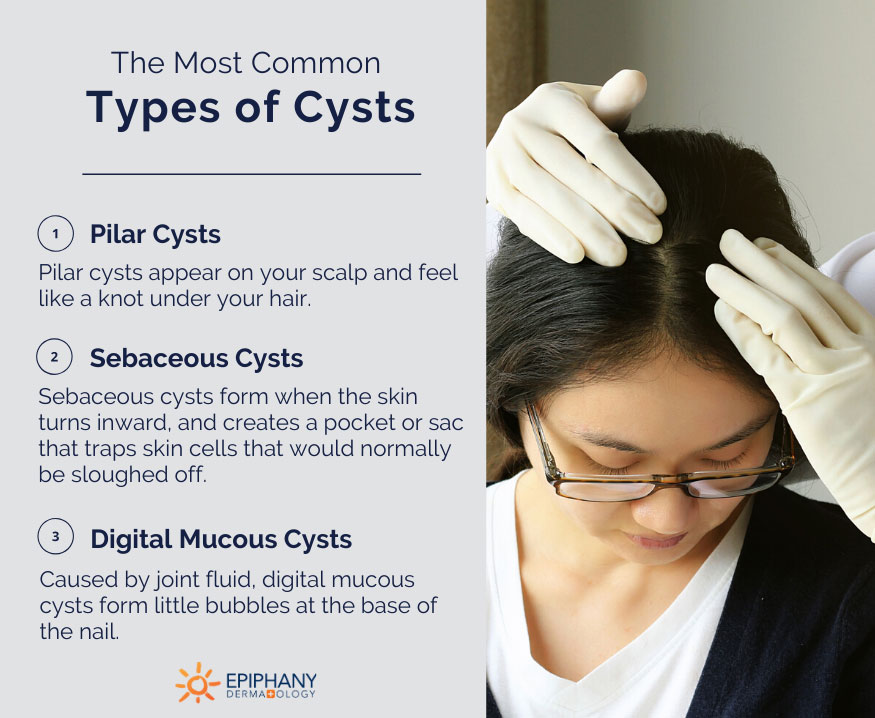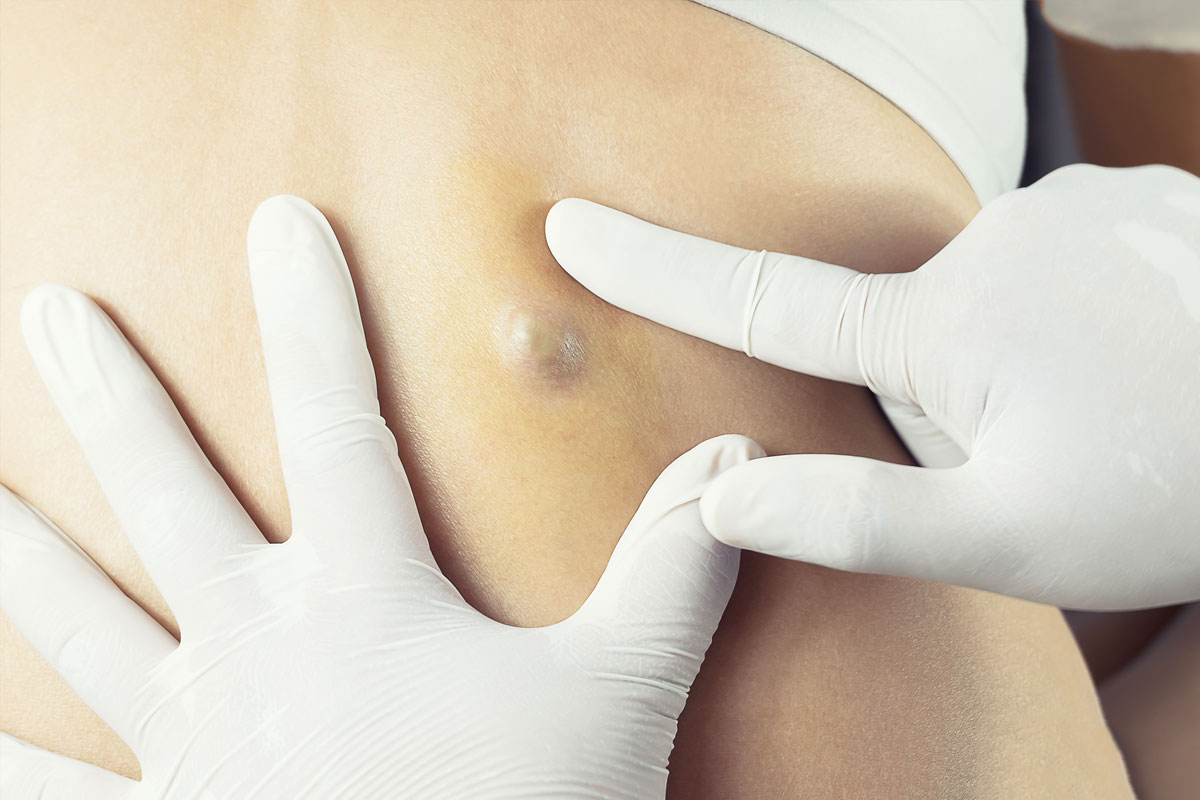What is a Cyst?
A cyst is a sac that forms in the body — it can form in bones, organs, or tissues. The cysts that form in the skin are essentially a pocket that is filled with skin cells, bacteria, and/or pus. They vary dramatically in size and can be found anywhere on the body. As time goes by, more and more skin cells are trapped in the cyst causing the cyst to grow larger.
What Are the Symptoms of a Cyst?
A cyst feels like a little knot or kernel underneath the skin. It may begin as an ingrown hair or acne pore that becomes infected, creating an opportunity for the skin to get turned in on itself. A cyst feels like a bump or a knot in the skin. The cyst may become large enough to drain the rotten skin cells, these cells cause the putrid smell.
Common Types of Cysts
There are three common types of cysts in the skin, Pilar Cysts, Sebaceous Cysts, and Digital Mucous Cysts, and each have different characteristics. Different types of cysts occur in different parts of the body for different reasons, so it’s important to have a general understanding of cysts and, if you notice one developing, have it checked by a specialist.
Pilar Cysts
Pilar cysts appear on your scalp and feel like a knot under your hair. When left alone, they can cause hair loss on that part of your scalp, or they may even rupture, which is a painful and messy experience.
Sebaceous Cysts
Made famous in pimple-popping videos, these cysts return repeatedly after you squeeze them. Sebaceous cysts form when the skin turns inward, and creates a pocket or sac that traps skin cells that would normally be sloughed off.
Digital Mucous Cysts
Caused by joint fluid, digital mucous cysts form little bubbles at the base of the nail. Usually, they form from the joint closest to the nail as a clear, hard bubble (like a blister). If punctured, they contain a thick sticky liquid that is the fluid that lubricates the joint.

What Causes Cysts?
A cyst happens when the skin turns in on itself. Think of the skin like a flat balloon. If the balloon has something inside (like skin cells) to push out, it naturally pushes it out through the opening. But if something plugs that opening, the cells are trapped inside the balloon. The balloon becomes a pocket for these cells that can’t leave.
We naturally slough off old skin cells from our skin and pores. But, if the pores are clogged up, the skin cells become trapped inside our skin, forming a cyst or a pocket of dead skin cells.
So why does the pore suddenly stop functioning right? Maybe you squeeze a pimple and damage the skin more than you realize. Other times, it starts with something small like an infected hair follicle or an acne cyst. The pore gets clogged, dead skin cells get trapped, and a cyst is formed.
Treatment Options for Cysts
If a cyst becomes infected, it can limit the treatment options to draining and antibiotics. The sooner you see a dermatologist after noticing a cyst, the smaller the chance of pain developing or the cyst coming back. If you’re not sure if you have a cyst, see a dermatologist and let an expert make the diagnosis.
Cyst Removal
It’s best to have a cyst removed by a dermatologist before it bursts. This small outpatient surgery will eliminate the problem for good.
During a cyst removal, the doctor will mark and numb the area around the bump. You’ll get a few Lidocaine injections that may slightly sting, but after that you won’t feel the procedure.
The dermatologist will then remove the pocket of skin cells, and put stitches on the inside and outside of the skin that will last for about two months. The skin will heal from the inside out.
If your doctor repairs your skin correctly, you’ll only have a small, smooth scar.
An Important Note About DIY Cyst Removal
At-home cyst removals do not work. There are plenty of YouTube videos showing home remedies for treating cysts. Do NOT try them. When people mash and lance their cysts, trying to squeeze out the inside, the cysts will just come back.
Remember, a cyst is a pocket in your skin lined with cells. The skin will continue to produce cells and refill the pocket as long as the pocket is there. You’re not treating the problem by squeezing the cyst. The pocket has to be removed.
What to Expect During A Cyst Removal
A cyst removal is a relatively simple procedure. It should take no longer than 30 minutes to remove most cysts.
If you can handle the small sting of a shot, you can handle a cyst removal. The doctor first topically numbs the cyst area and then injects Lidocaine. You may feel a slight sting, but that’s the most painful part.
FAQs About Cysts
Does Insurance Cover Cyst Removal? How Much Does It Cost to Remove a Cyst?
Insurance usually covers cyst removals. Since a cyst removal is a medical procedure (not cosmetic), the costs go against your deductible. Exact cyst removal costs depend on your insurance and whether you’ve met your deductible. Remember, you’ll have to pay out-of-pocket if you haven’t met your deductible, but cyst removal costs usually count towards that amount.
When Should I See My Dermatologist About a Cyst?
If you feel something hard under your skin, get it checked out as soon as possible. It may be a normal cyst that the doctor can easily remove, but it could also be something different.
Additional Resources
Click here to find an Epiphany provider near you.

Dr. R. Todd Plott is a board-certified dermatologist in Coppell, Keller, and Saginaw, TX. His specialization and professional interests include treating patients suffering with acne, identifying and solving complex skin conditions such as psoriasis, rosacea, atopic dermatitis, and identifying and treating all types of skin cancers. In his spare time, Dr. Plott enjoys cycling, traveling with his wife, and spending time with his children and new grandson.
Learn more about Dr. Plott.

